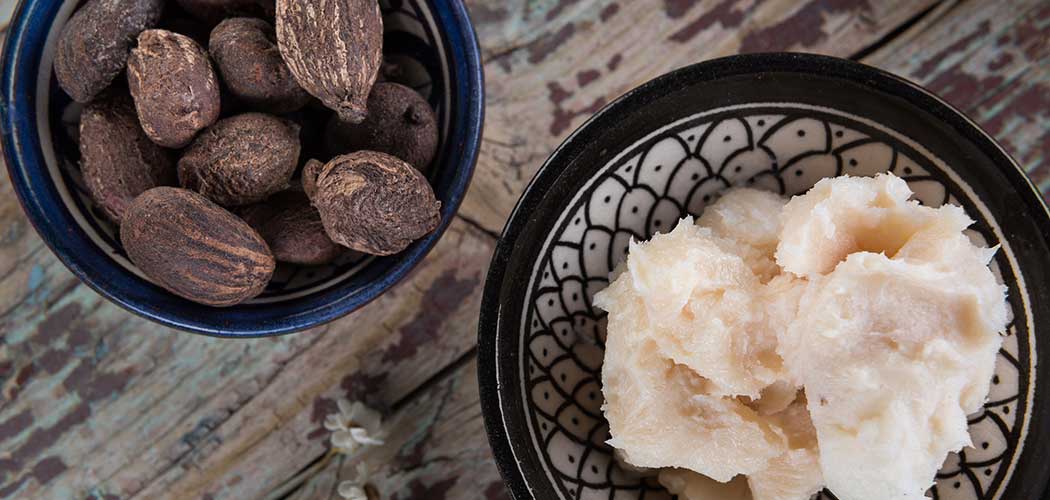Let’s face it. We love high-quality natural ingredients. We try to eat healthy and limit the amount of processed foods we consume. We want that same quality in everything we put on our skin, too. We seek out lotions and ointments with ingredients that look more like things we could conceivably grow or at least find in an upscale health food store and less like a chemistry class syllabus.
And so, let’s start exploring ingredients. First up, a rising superstar: shea butter. It’s the first ingredient in Hope Smith’s recipe for MUTHA™ Body Butter, but it’s not new to the world of high quality skin care. The use of shea butter has grown enormously over the last ten years. It’s suddenly in so many products. Ever wonder what the heck it is and why it’s so sought after?
Get ready. We’re going deep.
Shea Butter Comes from Tree Nuts
That’s right. Shea butter comes from fruit harvested from shea trees which grow in African countries along the savanna region from the Ethiopian highlands in the east to Senegal in the west.
Key word: harvest. Shea trees, which can live hundreds of years, bear fruit which can be sustainably harvested and processed. These trees provide an annual source of income for women in rural agricultural communities. Of course, there’s factory-processed shea butter, but the quality isn’t as good as the handmade product.
Shea tree fruit has within it an oil-rich nut or seed which is dried, roasted, ground, and boiled to become shea butter. In many African countries the oil is used in the preparation of traditional foods as well as other products like moisturizers, hair conditioners, soaps, and medicines.
Shea butter is an amazingly versatile product. It’s cultivation and production can support women and small sustainable farming. And, it’s edible, too. Shea is now sometimes used as a substitute for cocoa butter in making chocolate. It must be stated that while it is plant-based and can be edible, we do not recommend eating the processed product, unless it’s specifically marked for consumption. Please use MUTHA™ shea butter products on your skin, not on your tongue.
But What Makes Shea Butter So Good for Your Skin?
We’re so glad you asked.
Shea butter is a naturally occurring super-fatty acid and antioxidant. That sounds amazing, right? Yeah! But, we didn’t know what any of that really meant. So we asked Hope. As an educated esthetician, product guru, and true MUTHA™, Hope assigned us the task of finding out for ourselves and sharing our work with you.
- First, shea butter is what’s known as a natural emollient. That means it’s a skin softener – just as it is.
- Its consistency is firm at room temperature but softens and melts into the skin at body temperature, sealing in moisture.
- Shea butter contains fatty acids such as oleic, stearic, palmitic, and linoleic acid which create a moisturizing and protective barrier. These are healthy vegetable fats found in olive oil, seeds, and nuts.
- Shea butter is also an anti-inflammatory, according to Japanese researchers. Which means, it doesn’t just coat your skin. It soothes your skin, which reduces inflammation.
- And, shea butter has an unusually high level of natural vitamin E. And, vitamin E is a natural antioxidant which is great for your skin.
According to the Mayo Clinic, “Antioxidants are substances that may protect your cells against free radicals, which may play a role in heart disease, cancer, and other diseases. Free radicals are molecules produced when your body breaks down food or when you’re exposed to tobacco smoke or radiation.”
There are so many positive claims about shea butter, we could go on for days about it. In this post, we have only included a few top points. The key take-away is that shea butter moisturizes and has properties that help your skin heal itself.
Natural Ingredients Are Important for Your Skin
Remember when we told you the skin is an organ? For your skin to do its job excreting waste out of your body, it’s got to be in top shape. That’s why you want your skincare products to be as close to natural as possible. That’s why when Hope went searching for a wholesome clean product to reduce stretch marks when she was pregnant, she ended up making her own with shea butter at its core.
For more Hope-approved nutrition tips, check out more information on seasonal superfoods.
